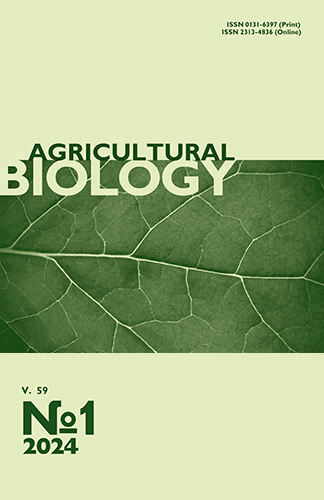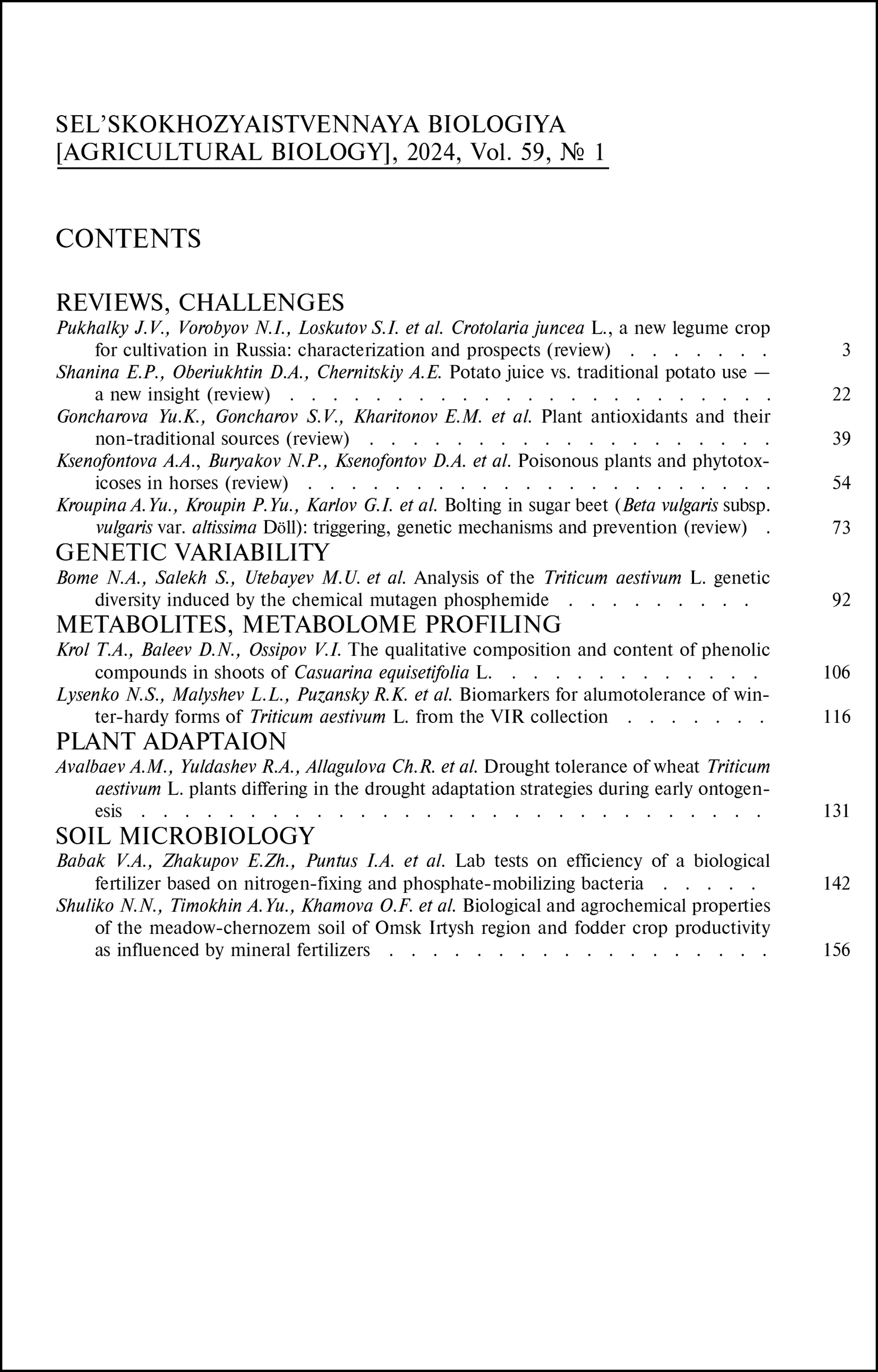doi: 10.15389/agrobiology.2024.1.142eng
UDC: 633:631.8:632.95:631.46
LAB TESTS ON EFFICIENCY OF A BIOLOGICAL FERTILIZER BASED ON NITROGEN-FIXING AND PHOSPHATE-MOBILIZING BACTERIA
V.A. Babak ✉, E.Zh. Zhakupov, I.A. Puntus, A.N. Fomina
«BIOTRONProgress» LLT, 021500 Republic of Kazakhstan, Akmola Province, Stepnogorsk, Industrial zone 4, complex 7, e-mail vgavm2003@mail.ru (✉ corresponding author), zhakupov_bio@mail.ru, puntusira@mail.ru,vgavm2003@mail.ru
ORCID:
Babak V.A. orcid.org/0000-0003-1860-1210
Puntus I.A. orcid.org/0009-0004-0628-5999
Zhakupov E.Zh. orcid.org/0000-0002-7294-257X
Fomina A.N. orcid.org/0000-0001-8655-0879
Final revision received May 15, 2023
Accepted December 28, 2023
Soil microbiota has a direct impact on ыoil fertility and composition and, as a consequence, on plant productivity. Currently, agricultural production requirements focus on biological farming the essence of which is to use the potential capabilities of natural ecosystems, in particular soil microorganisms. The most extensive and diverse group of soil microorganisms in properties are free-living and symbiotic nitrogen-fixing bacteria. Another group, phosphate-mobilizing soil microorganisms, participate in the conversion of hard-to-reach inorganic and organic phosphates into water-soluble forms assimilated by plants. Environmentally friendly and safe complex biological fertilizers based on isolates of microorganisms from local natural biogeocenoses are important to increase crop yields and improve soil fertility in the conditions of Kazakhstan. The purpose of the submitted work was a lab assessment of the effectiveness of a combined biological fertilizer based on phosphate-mobilizing and nitrogen-fixing bacteria and its compatibility with some fungicidal and herbicide preparations used in the Republic of Kazakhstan. In pot trials, the biological fertilizer BioAzo-Phosfit based on nitrogen-fixing bacteria Raoultella oxytoca MS and phosphate-mobilizing bacteria Serratia plymuthica MS was tested on cucumber seedlings of the Meva variety and spring wheat seeds of the Akmola 2 variety. Tests confirmed the effectiveness of the combined biological fertilizer on cucumber plants according to the main biometric indicators (e.g., length of stem and internodes, number and size of fruits). It was revealed that the average fruit length in the treatment was 12.4 % (p < 0.05) greater than in the control, and the total weight of harvested fruits in the treatment was 20.3 % (p < 0.05) greater than in control. Biofertilizer BioAzoPhosfit showed effectiveness on spring wheat after pre-sowing seed treatment. The treated seeds produced more vigorous shoots (the proportion of seedlings that sprouted by the set date was 5.2 % higher), and the plants from the treated seeds were significantly (p < 0.05) ahead of the control ones in growth and development throughout the entire observation period (by 12-31 %). In lab tests with the main fungicidal (Flamingo, Dividend Extreme) and herbicide (Assoluta, Tribune, Glyphosate and Smerch) preparations used on wheat in Kazakhstan, the combined biofertilizer BioAzoPhosfit showed a decrease in the viability of living microorganisms under the influence of broad-spectrum herbicides Glyphosate and Smerch. All other fungicides and herbicides tested slightly suppressed microbial cultures. Therefore, we recommend not using biofertilizers based on live microorganisms with broad-spectrum herbicides. The results of the tests allow us to recommend the growth and productivity parameters we used in this work for laboratory express testing the quality of microbiological preparation batches.
Keywords: rhizobacteria, nitrogen-fixing bacteria, phosphate-mobilizing bacteria, biological fertilizer, fertility, fungicide, herbicide.
REFERENCES
- Tereshchenko N.N. Bioudobreniya na osnove mikroorganizmov: uchebnoe posobie [Biofertilizers based on microorganisms: a tutorial]. Tomsk, 2003 (in Russ.).
- Sytnikov D.M. Biotekhnologiya, 2012, 5(4): 34-45 (in Russ.).
- Til’ba V.A., Shkarupa M.V. Maslichnye kul’tury, 2019, 1(177): 104-109 CrossRef (in Russ.).
- Ignatov V.V. Sorosovskiy obrazovatel’nyy zhurnal, 1998, 9: 28-33 (in Russ.).
- Ortiz A., Sansinenea E. The role of beneficial microorganisms in soil quality and plant health. Sustainability, 2022, 14(9): 5358 CrossRef
- Froussart E., Bonneau J., Franche C., Bogusz D. Recent advances in actinorhizal symbiosis signaling. Plant Molecular Biology, 2016, 90(6): 613-622 CrossRef
- Rosenblueth M., Ormeño-Orrillo E., López-López A., Rogel M.A., Reyes-Hernández B.J., Martínez-Romero J.C., Reddy P.M., Martínez-Romero E. Nitrogen fixation in cereals. Front. Microbiol., 2018, 9(9): 1794 CrossRef
- Tikhonovich I.A., Zavalin A.A. Plodorodie, 2016, 5: 28-32 (in Russ.).
- Alferov A.A., Chernova L.S., Zavalin A.A., Chebotar’ V.K. Vestnik rossiyskoy sel’skokhozyaystvennoy nauki, 2017, 5: 21-24 CrossRef (in Russ.).
- Soumare A., Diedhiou A.G., Thuita M., Hafidi M., Ouhdouch Y., Gopalakrishnan S., Kouisni L. Exploiting biological nitrogen fixation: a route towards a sustainable agriculture. Plants, 2020, 9(8): 1011 CrossRef
- Shvartau V.V., Gulyaev B.I., Karlova A.B. Fiziologiya i biokhimiya kul’turnykh rasteniy, 2009, 41(3): 208-220 (in Russ.).
- Mikhaylovskaya N.A., Mikanova O.A., Barashenko T.B., Tarasyuk E.G., Dyusova S.V. Pochvovedenie i agrokhimiya, 2011, 2(47): 120-129 (in Russ.).
- Jha B.K., Gandhi Pragash M., Cletus J., Raman G., Sakthivel N. Simultaneous phosphate solubilization potential and antifungal activity of new fluorescent pseudomonad strains, Pseudomonas aeruginosa, P. plecoglossicida and P. mosselii. World J. Microbiol. Biotechnol, 2009, 25(4): 573-581 CrossRef
- Djuuna I.A.F., Prabawardani S., Massora M. Population distribution of phosphate-solubilizing microorganisms in agricultural soil. Microbes and Environments, 2022, 37(1): ME21041 CrossRef
- Belyasova N.A., Ignatovets O.S., Sergievich D.S., Minakovskiy A.F. Vestnik Belorusskoy gosudarstvennoy sel’skokhozyaystvennoy akademii, 2018, 2: 93-97 (in Russ.).
- Aasfar A., Bargaz A., Yaakoubi K., Hilali A., Bennis I., Zeroual Y., Kadmiri I.M. Nitrogen fixing azotobacter species as potential soil biological enhancers for crop nutrition and yield stability. Frontiers in Microbiology, 2021, 12: 1-19 CrossRef
- Kursakova V.S., Khizhnikova T.G., Novikova L.A. Vestnik Altayskogo gosudarstvennogo agrarnogo universiteta, 2014, 2(112): 23-27 (in Russ.).
- Park J., Bolan N., Mallavarapu M., Naidu R. Enhancing the solubility of insoluble phosphorus compounds by phosphate solubilizing bacteria. Proc. 19-th World Congress of Soil Science, Soil Solutions for a Changing World. Brisbane, Australia, 2010: 65-68.
- Zavalin A.A., Alferov A.A., Chernova L.S. Agrokhimiya, 2019, 8: 83-96 CrossRef (in Russ.).
- Zlotnikov A.K., Alekhin V.T., Andrianov A.D., Andrianov D.A., Apasov I.V., Balandina A.V., Begunov I.I., Boronin A.M., Volkova G.V., Gamuev V.V., Gins V.K., Gins M.S., Glazova Z.I., Derov A.I., Dolgushkin A.K., Dulov M.I., Durynina E.P., Zhdanov N.S., Zhuk G.P., Zaytseva L.A., Zakharkina R.A., Zeyruk V.N., Zlotnikov K.M., Zubarev A.A., Ivanova N.N., Kazakov A.V., Kazakova M.L., Kargin Yu.I., Kirsanova E.V., Kononkov P.F., Kostin D.A., Kudryavtsev N.A., Lebedev A.V., Lebedev V.B., Likhacheva A.E., Maslov M.I., Pakhnenko O.A., Perov N.A., Popov Yu.V., Pukhova L.F., Romanova E.V., Rukin V.F., Ryabchinskaya T.A., Ryabchinskiy A.V., Sadovnikova L.K., Sarantseva N.A., Safonov P.A., Sergeev V.R., Sibikeeva Yu.E., Slobodyanyuk V.M., Strelkov E.V., Syroizhko N.P., Talash A.I., Trots A.P., Kharchenko G.L., Khryukina E.I., Shulyakovskaya L.N. Biopreparat Al’bit dlya povysheniya urozhaya i zashchity rasteniy: opyty, rekomendatsii, rezul’taty primeneniya [Biological product Albit for increasing yield and protecting plants: experiments, recommendations, application results]. Moscow, 2008 (in Russ.).
- Bobrenko I.A., Popova V.I., Kormin V.P., Goman N.V., Boldysheva E.P., Chernyavskaya M.A. Elektronnyy nauchno-metodicheskiy zhurnal Omskogo GAU, 2021, 4(27): 1-6 (in Russ.).
- Mosa W., Sas-Paszt L., Frąc M., Trzciński P. Microbial products and biofertilizers in improving growth and productivity of apple — a review. Polish Journal of Microbiology, 2016, 26; 65(3): 243-251 CrossRef
- Serratia plymuthica strain. Available: https://www.ncbi.nlm.nih.gov/nuccore/KJ729609. Accessed: 03/18/2022.
- Neminushchaya L.A., Skotnikova T.A., Tokarik E.F., Koval’skiy I.V., Eremets N.K., Pavlenko I.V., Provotoroka O.V., Eremets V.I., Samuylenko A.Ya., Kanarskaya Z.A. Vestnik tekhnologicheskogo universiteta, 2015, 18(2): 377-382 (in Russ.).
- Allouzi M.M.A., Allouzi S.M.A., Keng Z.X., Supramaniam C.V., Singh A., Chong S. Liquid biofertilizers as a sustainable solution for agriculture. Heliyon, 2022, 8 (12): 12609. CrossRef
- Voitka D.V., Yankovskaya E.N., Radevich S.Yu., Garko L.S., Fedorovich M.V. Zashchita rasteniy (Belarus’), 2018, 42: 306-315 (in Russ.).
- Mohiddin, F.A., Khan M.R. Tolerance of fungal and bacterial biocontrol agents to six pesticides commonly used in the control of soil borne plant pathogens. African Journal of Agricultural Research, 2013, 43(8): 5331-5334.
- Dasgupta D., Kumar K., Miglani R., Mishra R., Kumari P.A., Bisht S.S. Microbial biofertilizers: recent trends and future outlook. In: Recent advancement in microbial biotechnology. S. De Mandal, A. Kumar Passari (eds.).Academic Press,2021, 1: 1-26 CrossRef
- Korshikov A.V. Izvestiya Orenburgskogo gosudarstvennogo agrarnogo universiteta, 2005, 1(5-1): 83-84 (in Russ.).
- Mohammadi A.T., Amini Y.S. The influence of pesticides and herbicides on the growth and spore germination of Trichoderma harzianum. Agriculture Science Developments, 2015, 4(3): 41-44.
- Constantinescu F., Sicuia O.-A., Tu C.F, Dinu M.M., Andrei A.-M., Mincea C. In vitro compatibility between chemical and biological products used for seed treatment. Scientific Papers. Series A. Agronomy, 2014, LVII: 146-151.












